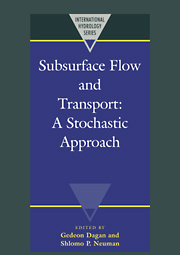Book contents
- Frontmatter
- Contents
- List of contributors
- Preface
- Acknowledgments
- I INTRODUCTION
- II SUBSURFACE CHARACTERIZATION AND PARAMETER ESTIMATION
- III FLOW MODELING AND AQUIFER MANAGEMENT
- IV TRANSPORT IN HETEROGENEOUS AQUIFERS
- 1 Transport of inert solutes by groundwater: recent developments and current issues
- 2 Transport of reactive solutes
- 3 Nonlocal reactive transport with physical and chemical heterogeneity: linear nonequilibrium sorption with random rate coefficients
- 4 Perspectives on field-scale application of stochastic subsurface hydrology
- V FRACTURED ROCKS AND UNSATURATED SOILS
- VI A VIEW TO THE FUTURE
4 - Perspectives on field-scale application of stochastic subsurface hydrology
Published online by Cambridge University Press: 04 December 2009
- Frontmatter
- Contents
- List of contributors
- Preface
- Acknowledgments
- I INTRODUCTION
- II SUBSURFACE CHARACTERIZATION AND PARAMETER ESTIMATION
- III FLOW MODELING AND AQUIFER MANAGEMENT
- IV TRANSPORT IN HETEROGENEOUS AQUIFERS
- 1 Transport of inert solutes by groundwater: recent developments and current issues
- 2 Transport of reactive solutes
- 3 Nonlocal reactive transport with physical and chemical heterogeneity: linear nonequilibrium sorption with random rate coefficients
- 4 Perspectives on field-scale application of stochastic subsurface hydrology
- V FRACTURED ROCKS AND UNSATURATED SOILS
- VI A VIEW TO THE FUTURE
Summary
ABSTRACT Recent advances in the application of stochastic methods to naturally heterogeneous aquifer systems are summarized in the context of field-scale contaminant transport descriptions. Key results on contaminant advection, spreading and dispersion, mixing and dilution, and retardation are illustrated by comparisons with field observations, focusing particularly on the Cape Cod glacial aquifer system where hydraulic characterization and contaminant transport observations are available over scales ranging from a few meters to several kilometers. Both theoretical results and field observations point to the importance of characterizing heterogeneity as fully three-dimensional and anisotropic, and of including unsteadiness in the flow description. Relative dispersion analysis indicates that larger plumes will have larger macrodispersivities; this plume-scale effect is demonstrated quantitatively for the Cape Cod site. Mixing and dilution are controlled by the interplay between local dispersion and small-scale variations in hydraulic conductivity, suggesting the need to characterize hydraulic conductivity variations at scales down to centimeters. The important influence of the heterogeneity of reactive transport properties in enhancing longitudinal dispersion points to the need for systematic measurements of variations in such chemical characteristics. Unresolved research areas critical to effective application of stochastic methods to field problems include efficient characterization of heterogeneity over a wide range of scales (centimeters to kilometers), large-scale controlled field experiments on reactive transport and multiphase flow, and theoretical treatments of multiphase flow and highly heterogeneous media.
INTRODUCTION
It is now widely acknowledged that natural aquifer materials are heterogeneous in terms of their flow properties such as hydraulic conductivity, and it is becoming more widely recognized that chemical and biological properties affecting transport of contaminants in aquifers also vary erratically in space.
Information
- Type
- Chapter
- Information
- Subsurface Flow and TransportA Stochastic Approach, pp. 157 - 176Publisher: Cambridge University PressPrint publication year: 1997
Accessibility standard: Unknown
Why this information is here
This section outlines the accessibility features of this content - including support for screen readers, full keyboard navigation and high-contrast display options. This may not be relevant for you.Accessibility Information
- 13
- Cited by
